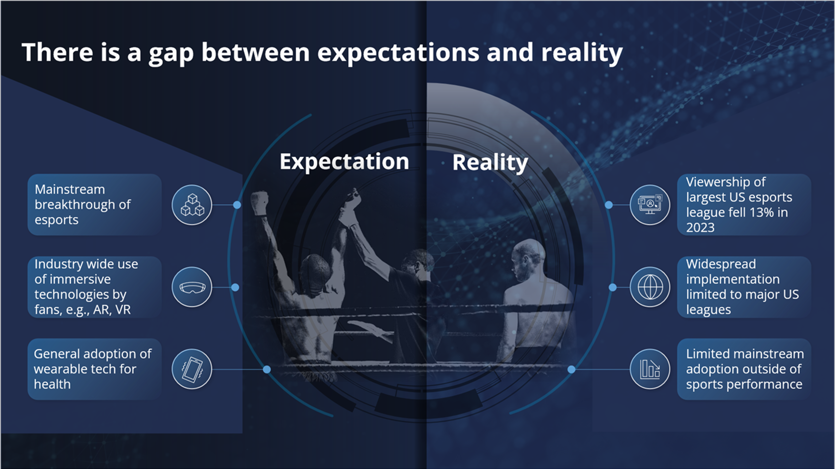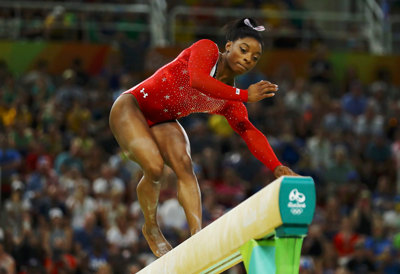The following article is based on a speech by David Portas (Founder and Executive Chairman of Portas Group) presented at the GSIC Conference in Singapore, January 17th 2024.
We need to approach our predictions for digital technology in sport with optimism, a dose of humility and some scepticism.
In 2007, the Microsoft founder and entrepreneur, Steve Ballmer, confidently declared, "There's no chance that the iPhone is going to get any significant market share. No chance."
Clearly, predicting the future is a sport in itself.
We can all see a big opportunity, but it still feels distant at board table. We have been talking about this “transformational opportunity” for at least 10 years – but who within the traditional legacy sports bodies have committed to the innovation required to make the transformation happen? Have they truly embraced the immense opportunities for collaboration and integration between sports and technology?
The goal of this presentation is to provide an understanding of how to capture the value of digital transformation in sport and technology.
Technology is already helping to enhance performance and fan experiences
There are many examples:
- AR applications in stadiums, such as the fan experience enhancements seen in the NBA, increase fan engagement and attendance. Recent research also suggests AR is a key driver of para-athlete enablement (Loughborough University)
- The Tokyo Olympics in 2021 garnered 5 billion digital views globally. Accessibility is no longer a challenge; it's an opportunity. (IOC)
- Sports teams employing data analytics, like the use of Sabermetrics in baseball, have seen a 20% improvement in player performance.
The industry has only scratched the surface of this immense opportunity.
It is predicted that investment in sport technology will grow significantly. To give some idea of the scale of the opportunity:

- While there is no global reference point, a conservative prediction suggests the global sports technology market is currently valued at $15-30 billion and is projected to grow at an annual rate of 20% to reach $50-100 billion in 2030. (Grandview Research, PwC Sports Industry Outlook)
- This is a real opportunity in Asia with the sports industry expected to grow at an annual growth of 6.5%, second only to the Middle East at 13.5%, with Sports Technology leading the charge at 17% CAGR. (Grandview Research, Asia Sports Tech)
Numbers and future predictions for sports tech over the years have been based on weak and often quickly outdated research, gross generalisations and extrapolations. Nevertheless, most industry practitioners agree on the orders of magnitude, and that sport has a unique opportunity to embrace digital to truly drive transformational change and extract value through technology.
A Reality Check
However, despite these numbers, we have also seen a gap between expectations and reality. For example:
- Even in the realm of esports, forecast to be $1.5 billion in revenue by 2025, the anticipated mainstream breakthrough has been slower than expected, despite significant investment and interest.
- The use of VR for athlete training and fan engagement, while extremely promising, has yet to reach its full potential due to cost, technical and accessibility challenges.
- In wearable tech, the anticipated widespread adoption for personalized fan experiences or health monitoring, has faced cost, privacy concerns and integration issues.

This implementation gap between expectations and reality has resulting in a distinct value realisation gap:
The Value Gap
Unlocking the benefits at scale has proven challenging even for legacy industries. The structure of the sector is changing. But there are major differences in conduct and performance. Research aross other industries has shown that ‘leaders’ in digital transformation have grown revenue at 5 times the rate of ‘’laggards’, and there is no reason to believe sport is an exception. (Accenture)
In fact despite the bullish predictions we estimate there is a $10-15bn prize at stake. This is a very conservative estimate.
Why is this and what can we do?
The following insights are based on Portas client experiences, and recent research carried out in partnership with GSIC (Portas – GSIC joint research ‘ Digital Transformation in Sports’).

Thisvalue gap is the result of 3 main themes:
1. Digital strategy and plans
2. Digital infrastructure
3. Organisational capacity and capabilities
Digital Strategy & Plans

While a holistic digital approach is acknowledged as crucial by 88% of sporting organisations we surveyed, a mere 30% of sports organizations have dedicated and robust digital strategies or plans. In other words, while most sports organizations recognize the importance of digital transformation, only a fraction have a dedicated strategy towards achieving their ambitions. Over half of the respondents have already invested more than $0.5m in technology and innovation, but with limited strategic focus.
This is a distinct opportunity for disruption, innovation, and leadership.
Those who act now, prioritizing the development of a focused, flexible, and fit for purpose digital strategy, stand to gain a significant competitive advantage in a rapidly disrupted industry.
Digital Infrastructure

Portas and GSIC’s joint research indicated that upgrading digital assets, creating social content, and incorporating AI ranked highest among the digital technology priorities of sporting organisations. Anecdotal evidence and interviews highlighted that many respondents didn’t fully understand what these would actually entail, andthis gap in understanding is widening.
In a world of real time data, evolving customer expectations and the rapid emergence of technology, an approach to follow customer trends and deploy the latest application poses risks in achieving broader business objectives. Especially as investments in enabling infrastructure lag behind other customer facing offerings.
It also poses some major challenges for organizations currently grappling with where to play and how to play. Technology is evolving so fast, investments committed to last year may no longer be relevant. “Late adoption” is therefore not a long-term winning strategy.
According to Accenture, organizations investing in digital enablement have seen a 30% reduction in operating expenses (Accenture)). However, there has also been a spike in the volume and type of cyber-attacks affecting organizations in the last 12 months.
Therefore, creating a robust enabling architecture that supports digital transformation will require investing not just in front-end customer-facing technologies, but in establishing clear, consistent, and holistic digital platform strategies that can unlock potential in the long term and protect the organisation.
This shift towards a more interactive, secure, and commercially viable approach is not a choice. Developing the right digital infrastructure is not just a technical necessity; it's a strategic and commercial imperative. By investing in enabling capabilities, organizations can unlock the full potential of digital technologies, leading to improved operational efficiency, security, and more immersive fan and client experiences.
Organizational Barriers

Limited organizational capacity (an issue for 95% of respondents), financial constraints, and a lack of digital talent were cited as the biggest barriers.
Very few leaders in sport would describe themselves as ‘digital natives’ or even ‘digital immigrants’. They cite the lack of quality advice from those who understand the sports industry, business and digital opportunities. These are being termed ‘digital interpreters’.
Addressing organisational challenges, financial constraints and talent gaps is crucial not just for digital transformation but for organizational resilience in this digital age - overcoming these barriers is essential for fostering innovation and securing a leading position in the digital sports arena they now operate in.
Requirements for fundamental change
There is no question the industry stands at a pivotal moment where the future of sports is being reshaped by digital innovations.
But it is questionable if sports is truly ready to bridge the gap between its traditional values and the emerging digital world. These organisational challenges require collaborative solutions, innovative thinking, and a willingness to invest in the future.
Instead of simply digitizing our existing business, how can we truly disrupt an industry and challenge the status quo?
Client experience from across the globe suggests that this innovation will not come from inside the industry today, rather true disruption and innovation will occur from outside the sector, as both emerging and established companies globally recognize the opportunity that is in front of them.
Winners will embrace 4 differentiating actions:

- Innovation: Sport is naturally conservative and resistant to change. It needs to unlock innovation and create opportunities for teams to challenge the status quo, try, test, succeed or fail, and learn rapidly. Leaders need to disrupt: embrace new business, operating, and engagement models that fundamentally challenge the existing way of thinking.
- Integration: The future of sport will not look like it does today. It must create opportunities and structures where to engage and collaborate with multiple partners and stakeholders in new ways – e.g. on-demand and flexible resourcing models or simplified commercial arrangements.Finding ways to integrate far better within their organisations across the many silos that exist in legacy sports’ organisations.
- Improvement: This will all require a mindset shift within sport – including an increased bias for action within organisations, developing digital capability to ensure faster adoption of new ideas and proactive management of transformational change. The sport industry will not ‘think itself into a new way of acting’ but needs to turn that around and ‘act its way into a new way of thinking’.
- Investment: Finally, it needs to look to new sources of investment to significantly increase funding into physical infrastructure, systems and human resources. Leaders need to explore new financial approaches and investment partnerships to secure the funding required. Legacy public funding,grant applications and sponsorship approaches aren’t enough.
Summary
The key to unlocking the value of the digital revolution in sport and technology is nothing less than a fundamental organisational transformation.
As sports leaders navigate this future, they need to remember the unpredictable nature of progress. This transformational journey requires agility, foresight, and a commitment to blending tradition with technological advancements.
They also need to embrace this digital transformation with a collaborative spirit and pragmatic approach. Not everyone in sport is a ‘digital native’ and so ‘digital interpreters’ are clearly needed to help guide them into unknown territory.
Only this way can leaders drive the future of sports towards a more impactful, inclusive and sustainable era using digital technology.
ABOUT PORTAS
Portas is the leading global strategy consultancy dedicated to sport and physical activity. Our mission is to help our clients harness the power of sport and physical activity for the benefit of all. With over 120 consultants, 4 offices globally and history of impacting sport at the highest level, Portas is proud to bring unparalleled expertise into shaping the future of sport. Find out more at portasconsulting.com
David Portas is a former Geoscientist, and former Partner at McKinsey, who founded Portas Consulting in 2006 after leading the development of the legacy strategy for the London Olympic bid. He has served Governments around the world, Olympic bids and organising committees, major national and international sports organisations and leaders of multinational corporations over the past 25 years.




